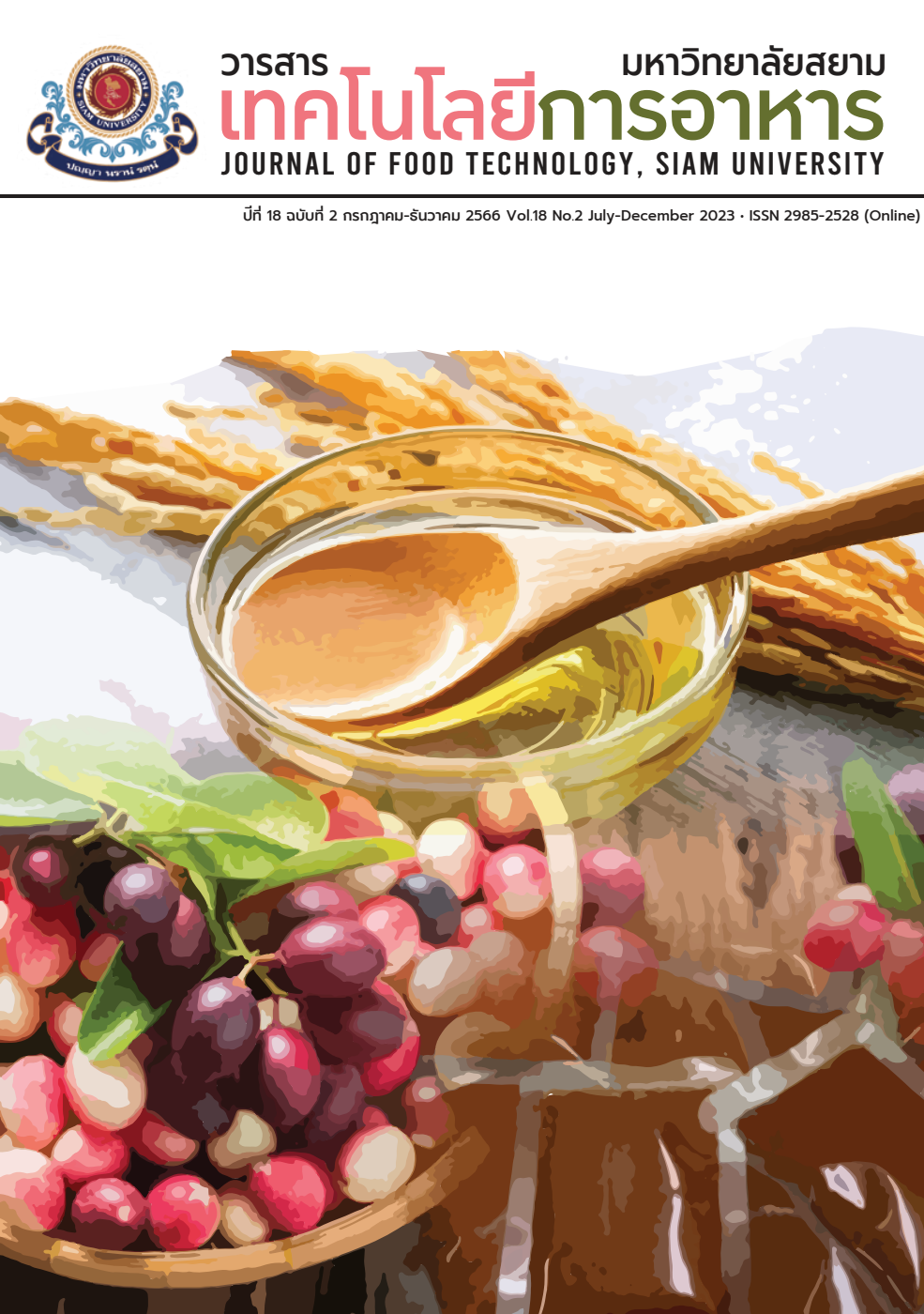สภาวะที่เหมาะสมในการสกัดเซลลูโลสและการเตรียมคาร์บอกซีเมทิลเซลลูโลสจากลำไยผลอ่อนที่เป็นของเหลือทิ้ง
Main Article Content
บทคัดย่อ
ลำไยผลอ่อนเป็นของเหลือทิ้งจากการตัดช่อลำไย ลำไยผลอ่อนนี้ประกอบด้วยส่วนที่เป็นเซลลูโลส ซึ่งสามารถสังเคราะห์ให้เป็นคาร์บอกซีเมทิลเซลลูโลส (carboxymethylcellulose, CMC) เพื่อใช้เป็นสารเติมแต่งในอาหาร วัตถุประสงค์ของงานวิจัยนี้ คือ ศึกษาสภาวะการสกัดเซลลูโลสจากลำไยผลอ่อนและเตรียม CMC จากเซลลูโลสที่สกัดได้ จากผลการทดลองพบว่าลำไยผลอ่อนประกอบด้วย เซลลูโลสร้อยละ 13.5 เฮมิเซลลูโลสร้อยละ 13.1 และลิกนินร้อยละ 11.7 (โดยน้ำหนัก) สภาวะที่เหมาะสมในการสกัดเซลลูโลส คือ สัดส่วนโซเดียมไฮดรอกไซด์ (ความเข้มข้นร้อยละ 6) ต่อผงลำไย คือ 80:20 ที่ 30 องศาเซลเซียส นาน 2 ชั่วโมง ได้เซลลูโลสหยาบร้อยละ 65.61 (โดยน้ำหนัก) จากนั้นนำเซลลูโลสหยาบนี้ไปสังเคราะห์เป็น CMC แล้วยืนยันผลโครงสร้างทางเคมีด้วย FTIR เทียบกับ CMC ทางการค้า พบค่าการดูดกลืนแสงที่ 3415 cm-1 และ 1628 cm-1 ซึ่งสอดคล้องกับหมู่ไฮดรอกซี (-OH) และหมู่คาร์บอกซิล (COOH) ในพอลิแซคคาไรด์ ตามลำดับ CMC จากลำไยผลอ่อนมีค่าความหนืดเท่ากับ 1574 cP และมีค่าความบริสุทธิ์ร้อยละ 81.34 ซึ่งมีค่าไม่แตกต่างอย่างมีนัยสำคัญทางสถิติระหว่าง CMC จากลำไยผลอ่อน และ CMC ทางการค้า ดังนั้นจะเห็นได้ว่าลำไยผลอ่อนซึ่งเป็นของเหลือทิ้งสามารถนำมาผลิตเป็น CMC เพื่อใช้ในผลิตภัณฑ์อาหารได้
Article Details

อนุญาตภายใต้เงื่อนไข Creative Commons Attribution-NonCommercial-NoDerivatives 4.0 International License.
บทความทุกบทความในวารสารเทคโนโลยีการอาหาร ทั้งในรูปแบบสิ่งพิมพ์ และในระบบออนไลน์ ถือเป็นลิขสิทธิ์ของมหาวิทยาลัยสยาม และได้รับการคุ้มครองตามกฎหมาย
เอกสารอ้างอิง
Mussatto, S.I., Ballesteros, L.F., Martins, S. and Teixeira J.A. (2012). Use of agro-industrial wastes in solid-state fermentation processes. Industrial Waste. 274: 121–139.
Abraham, E., Deepa, B., Pothan, L.A., Jacob, M., Thomas. S., Cvelbar, U. and Anandjiwala, R. (2011). Extraction of nanocellulose fibrils from lignocellulosic fibres: A novel approach. Carbohydrate Polymers. 86(4): 1468–1475.
Wang, W., Liu, C., Huang, F., Li, W. and Zheng, C. (2019). Preparation and characterization of nanocellulose from rapeseed hull. Oil Crop Science. 4(1): 55–64.
Hutomo, G.S., Marseno, D.W. and Supriyanto S.A. (2012). Synthesis and characterization of sodium carboxymethylcellulose from pod husk of Cacao (Theobroma cacao L.). African Journal of Food Science. 6:180-185.
Yue, Y., Han, J., Han, G., Aita, G.M. and Wu, Q. (2015). Cellulose fibers isolated from energy cane bagasse using alkaline and sodium chlorite treatments: Structural, chemical and thermal properties. Industrial Crops and Products. 76: 355-363.
Jia, F., Liu, H. and Zhang, G. (2016). Preparation of carboxymethyl cellulose from corncob. Procedia Environmental Sciences. 31: 98-102.
Rehman, N., Alam, S., Amin, N.U., Mian, I. and Ullah, H. (2018). Ecofriendly isolation of cellulose from Eucalyptus lenceolata: a novel approach. International Journal of Polymer Science. 1: 1-7.
Ye, H., Xu, S., Wu, S. and Chen, W. (2018). Optimization of sodium carboxymethyl cellulose preparation from bagasse by response surface methodology. IOP Conference Series: Materials Science and Engineering. 1: 1-6.
Heinze, T. and Pfeiffer, K. (1999). Studies on the synthesis and characterization of carboxymethylcellulose. Applied Macromolecular Chemistry and Physics. 266: 37–45.
Mondal, M.I., Yeasmin, M.S. and Rahman, M.S. (2015). Preparation of food grade carboxymethyl cellulose from corn husk agro waste. International Journal of Biological Macromolecules. 79: 144-150.
Candido, R.G. and Goncalves, A.R. (2016). Synthesis of cellulose acetate and carboxymethyl cellulose from sugarcane straw. Journal Carbohydrate Polymers. 152: 679-686.
Goering, H.K. and Van Soest, P.J. (1970). Forage fiber analysis (Apparatus, reagents, procedures, and some applications). In Agricultural Handbook No. 379, pp. 1-20. US Government Printing Office, Washington, DC.
Inari, G.N., Mounguengui, S., Dumarcay, S., Pétrissans, M. and Gérardin P. (2007). Evidence of char formation during wood heat treatment by mild pyrolysis. Polymer Degradation Stability. 92: 997–1002.
American Society for Testing and Materials. (2004). Method ASTM: D1439-03.
Jiang, M., Zhao, M.M., Zhou, Z.W., Huang, T., Chen, X.L. and Wang Y. (2011). Isolation of cellulose with ionic liquid from steam exploded rice straw. Industrial Crops and Products. 33 (3): 734-738.
Rahaman, M.S., Nahar, S.S., Islam, J.M.M., Samadder, R., Rahaman, M.S., Chadni, R.K., Shagor, F.R., Rahman, M.L., Ruhane, T.A., and Khan, M.A. (2022). Utilization of waste textile cotton by synthesizing sodium carboxymethyl cellulose: an approach to minimize textile solid waste. Advances in Polymer Technology. doi:10.1155/2022/4255409
Orue, A., Jauregi, A., Unsuain, U., Labidi, J., Eceiza A. and Arbelaiz, A. (2016). The effect of alkaline and silane treatments on mechanical properties and breakage of sisal fibers and poly (lactic acid)/sisal fiber composites. Composites Part A: Applied Science and Manufacturing. 84: 186–195.
Razali, N.A.M., Sohaimi, R. M., Othman, R.N.I.R., Abdullah, N., Demon, S. Z.N., Jasmani, L., Yunus, W.M.Z.W., Ya’acob, W.M.H.W, Salleh, E.M., Norizan, M.N. and Halim, N.A. (2022). Comparative study on extraction of cellulose fiber from rice straw waste from chemo-mechanical and pulping method. Polymers. 14(3): 387.
Abdul Karim, M.S., Zainol, N., Abu Hassan As’ari, N.I.A., Abu Talip Yusof, N. and Aziz, N.H. (2022). Effect of processing parameters on cellulose content extracted from pineapple leaf. Biocatalysis and Agricultural Biotechnology. 42:102339.
Wang, X., Li, H., Cao, Y. and Tang, Q. (2011). Cellulose extraction from wood chip in an ionic liquid 1-allyl-3-methylimidazolium chloride (AmimCl). Bioresource Technology. 102 (17): 7959-7965.
Hospodarova, V., Singovszka, E. and Stevulova, N. (2018). Characterization of cellulosic fibers by FTIR spectroscopy for their further implementation to building materials. American Journal of Analytical Chemistry. 9(6): 303-310.
Hidayat, S., Ardiaksa, P., Riveli, N. and Rahayu, I. (2018). Synthesis and characterization of carboxymethyl cellulose (CMC) from salak-fruit seeds as anode binder for lithium-ion battery. Journal of Physics: Conference Series.1080. 012017.
Pushpamalar, V., Langford, S.J., Ahmad, M. and Lim, Y.Y. (2006). Optimization of reaction conditions for preparing carboxymethyl cellulose from sago waste. Carbohydrate Polymers. 64(2): 312-318.
Rachtanapun, P., Luangkamin, S., Tanprasert, K. and Suriyatem, R. (2012). Carboxymethyl cellulose film from durian rind. LWT-Food Science and Technology. 48(1): 52-58.
Haleem, N., Arshad, M., Shahid, M. and Tahir, M.A. (2014). Synthesis of carboxymethyl cellulose from waste of cotton ginning industry. Carbohydrate Polymers. 113: 249-255.


